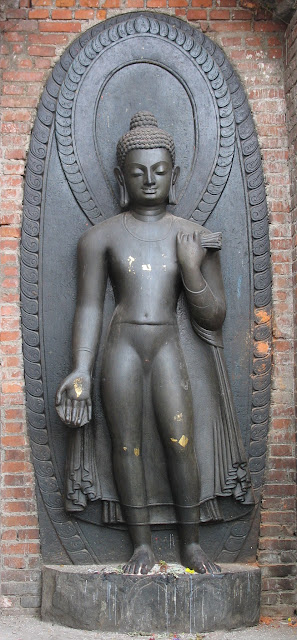 Pashupatinath
Pashupatinath, or
Pashupati, is a Hindu temple dedicated to a manifestation of Shiva called Pashupati (Lord of Animals). It attracts thousands of pilgrims each year. The temple itself is not open to non-Hindus, but anyone can wander around the area. Tania and I went there late in the evening with my 'adopted nephew,' Belief, and that was the only time that I have ever been there when there wasn't a crushing crowd.
I remember my first trip to Pashupati 18 years ago was very disturbing. There were maimed beggars and people who looked like they were dying lying on the ground. A vendor called me over and tried to sell me a highly decorated real human skull that was hidden behind a curtain. Then there was a strange green-eyed woman with a shaved head who stared at me and followed me around.
The place looked very different this time. I saw one holy baba asking for money, but that was probably because of the time of day. The vendors had been moved away from the temple, and the maimed people were gone. (If you will look closely at the top of the first photo, you will see a glowing mystery orb. These orbs were in all of the night photos I took in Nepal. My best guess is the camera flash reflected off of some dust.)
 The fire on the steps is a cremation
The fire on the steps is a cremationMy Nepali nephew had been there only a few weeks earlier with his family to preform the funeral ceremony for his grandfather. He explained what we witnessed. First the feet of the deceased are dipped into the Bagmati river at the bottom of the temple stairs and washed. Then the body is carried around and laid with flowers on the ghat, which is the pyre platform. Finally, the fire is lit. After the cremation, we saw some people wading in and sifting through the water collecting items that didn't burn.
This is all very public. Although non-Hindus can not be where the grieving families are. They can watch and take pictures from the bridge and the other side of the river. I asked my nephew if he found it disturbing or scary to be at Pashupatinath, because that was what I was feeling. But no, he felt that it was a safe place. For him it was a place of protection where you could understand that we would all be welcomed back to Shiva in the end. In fact, it is considered an auspicious place to die.

The temple complex included one tall building with a golden roof. For the first time, I saw inside the doors leading to the tall building when we walked around to the back side of the temple. Through wide open doors I could hear the powerful throbbing drum music coming from within. Inside was a massive golden bull, the steed of Shiva. It looked to me to be at least 15 feet tall surrounded by devotees. The sounds and sights were very exciting though a little spooky.

The last place that we stopped on Saturday, was Boudanath Stupa. I thought that it would be all lit up and beautiful. But the power was out, as usual. We ate vegetable momos at a restaurant that overlooked the stupa. Sitting by the window, we watched the pilgrims circumambulate and rotate their prayer wheels by the light of the offering candles.
...
The next day, we had to get up very early. We were leaving the valley, by jeep, for the mountain school.















































